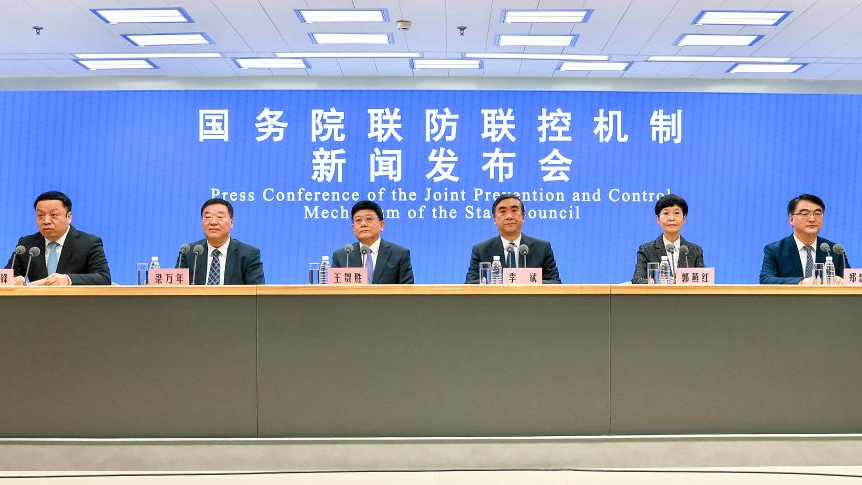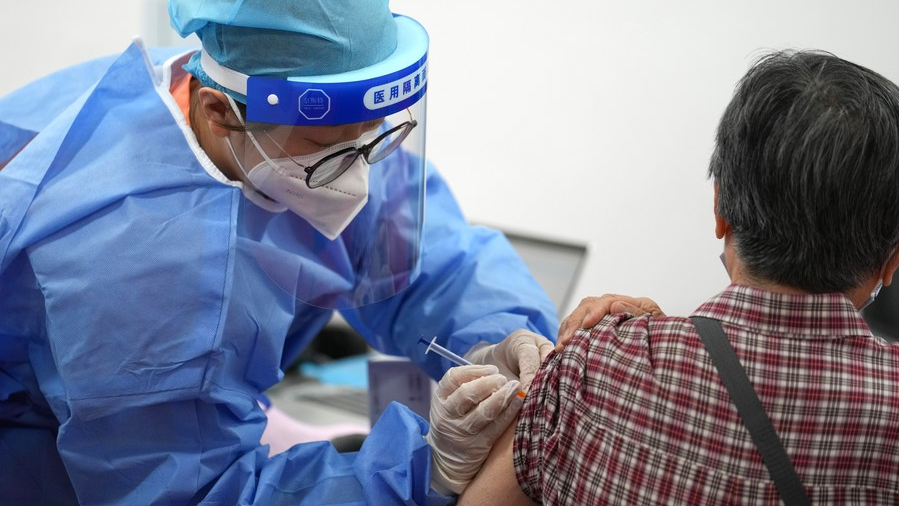
A press conference of the joint prevention and control mechanism of the State Council is held in Beijing, China, December 7, 2022. /Xinhua
A press conference of the joint prevention and control mechanism of the State Council is held in Beijing, China, December 7, 2022. /Xinhua
Editor's note: Lu Jiahai is a professor in the Department of Epidemiology from School of Public Health at Sun Yat-Sen University and the Director of National Medical Products Administration (NMPA) Key Laboratory for Quality Monitoring and Evaluation of Vaccines and Biological Products. The article reflects the author's opinions and not necessarily those of CGTN.
In early 2020, the COVID-19 epidemic broke out in Wuhan, China's Hubei Province. Amid the sudden outbreak, the Central Committee of the Communist Party of China (CPC) took decisive actions and responded, placing people's lives and health above all else. It launched a battle against the virus and mobilized the country to take life-saving measures on an unprecedented scale. China has been thinking about how to contain the virus at a lower cost and in shorter time, and how to reduce the impact of the epidemic on economic and social development over people's work and life.
China has put forward "putting people and their lives first" and adhered to the "dynamic zero-COVID" policy, which has maximized the protection of people's lives and health and established China as a global leader in balancing economic development and COVID-19 control.
Practice has proven that facing the ever faster spread of the global pandemic, a responsible country and its government should, firstly, do an effective job to prevent and control the pandemic at home. Secondly, it should cooperate with the international community. The Chinese government's strategy of "preventing both imported cases and domestic rebound" since the beginning of the pandemic shows how a responsible country should act.
Reflecting on the handling of the virus by different countries, unlike most Western countries which just threw hands up, China has adhered to the "dynamic zero-COVID" approach. As the virulence of the virus gradually declined and its transmissibility changed, the pandemic control measures got optimized. A series of measures were introduced in China one after another: the ninth edition of Protocol for Prevention and Control of COVID-19, the 20 measures to optimize the COVID-19 responses, and the latest 10 prevention and control measures, which testifies to China's response strategy of "precise and scientific epidemic prevention and control."

A medical worker injects a booster shot of COVID-19 vaccine for an 86-year-old citizen, Beijing, China, July 13, 2022. /Xinhua
A medical worker injects a booster shot of COVID-19 vaccine for an 86-year-old citizen, Beijing, China, July 13, 2022. /Xinhua
Recently, another major adjustment has been made to the prevention and control policy of COVID-19 in China. China will no longer manage COVID-19 as a Class A infectious disease, but rather as a Class B infectious disease starting on January 8, 2023. Response measures can be adjusted with regard to the quarantine of infected persons and their close contacts, the lockdown of areas with confirmed cases, transportation and quarantine requirement on inbound travelers and cargos. As a result, the number of cases starts to surge in China. Due to the differences in mobility, density and immunization of the population across China, there will be waves of outbreaks in different parts of the country. Still, we must put people and their lives first. This will require us to shift our focus from infection prevention to medical treatment, and to ensure the orderly transition to managing COVID-19 as a Class B infectious disease.
Accordingly, China has become a major country with the lowest COVID-19 incidence and death toll. In order to protect health and prevent serious illness, it is imperative to ensure people have access to health care and medicines, and keep vaccinating the population and take basic protective measures against the virus. As the virus keeps mutating, vaccination can help protect vulnerable groups. The full-dose of the vaccination rate for the entire population has exceeded 90 percent, with a total of over 3.46 billion doses getting administered nationwide. China has over 267 million elderly people over the age of 60, who are at high risk of suffering severe illness after being infected with COVID-19. Every one percentage point increase in the vaccination rate means that more than two million people will join in the immune barrier, which can reduce the risk of severe illness and death among the elderly.
On the occasion of the 70th anniversary of the patriotic health campaigns, President Xi Jinping said that the patriotic health campaigns have focused on people's health and given priority to prevention, playing an important role in changing the landscape of urban and rural environment and sanitation, effectively responding to major infectious diseases, and improving the level of social health management. After the outbreak of COVID-19, the CPC Central Committee and the State Council made swift decisions and arrangements. The National Health Commission took the lead in establishing a joint prevention and control mechanism, with working groups on epidemic prevention and control, medical treatment, scientific research, communications and foreign affairs, logistics, and frontline operations. The working groups are subject to clear division of responsibilities and work with each other to form effective synergy in COVID-19 response.
Within a very short period of time, China went from passive response at the initial stage to active control, aiming at eliminating the hazards from the source by frontloading the control efforts. This is a success story in controlling infectious diseases under the "One Health" system.
Over the past three years, the country has united as one and 1.4 billion Chinese people have stood by each other, forging a great spirit of fighting the pandemic and gaining confidence in the fight against it. In leading the fight against the pandemic, the Communist Party of China has put people's safety and health first, which has won heartfelt support of the general public in China and the recognition of public opinion overseas. Practice has proven that China's COVID-19 response strategy and policies are in line with its national realities, scientific and effective. They are recognized by the people and can stand the test of time.
(If you want to contribute and have specific expertise, please contact us at opinions@cgtn.com. Follow @thouse_opinions on Twitter to discover the latest commentaries in the CGTN Opinion Section.)